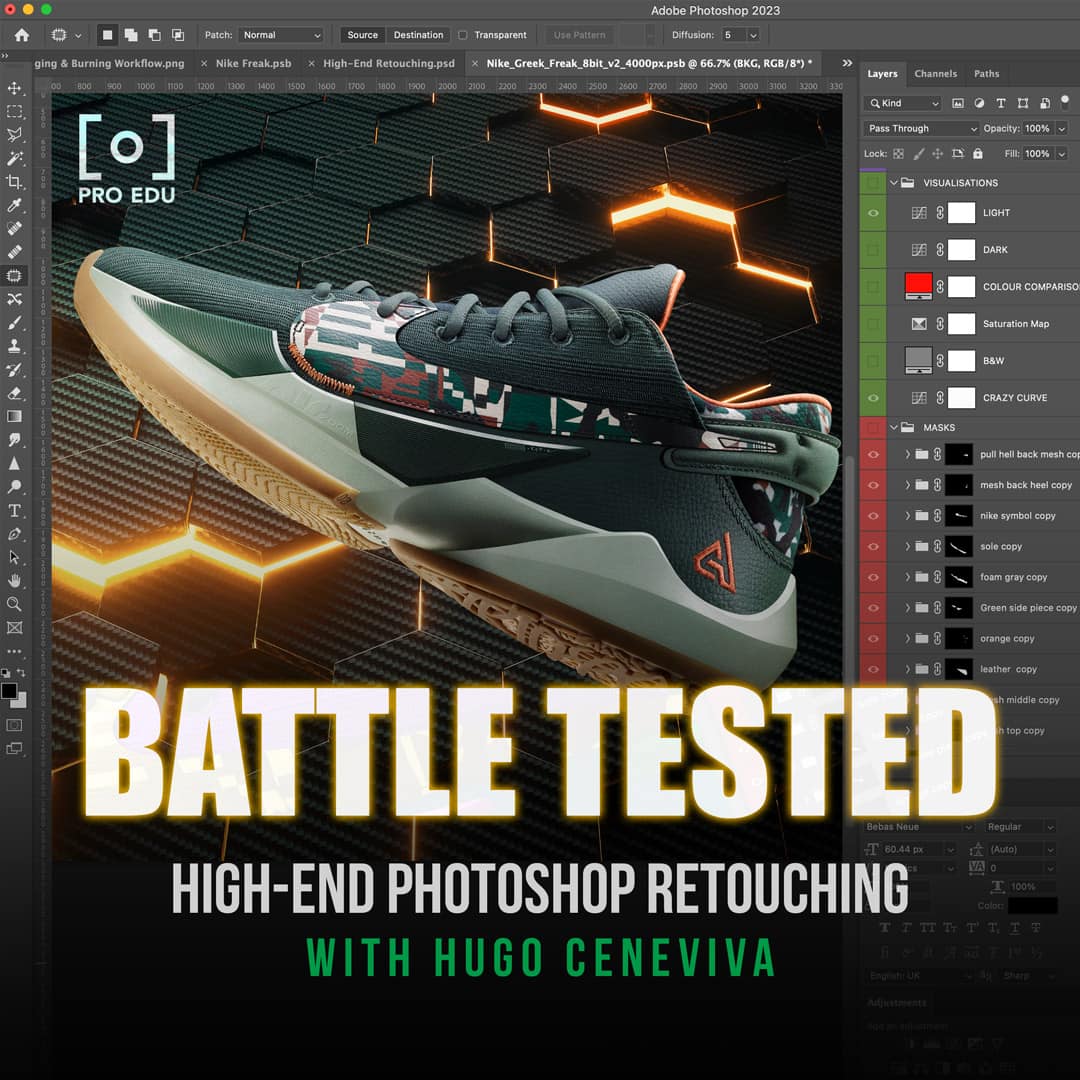Optimisation du flux de travail Photoshop pour les professionnels : rationalisez votre processus d'édition
En tant que professionnels de la création, nous comprenons que l'efficacité dans Adobe Photoshop ne se résume pas à la connaissance des outils, mais à la maîtrise du flux de travail. Un flux de travail optimisé nous permet de fournir un travail de meilleure qualité à un rythme plus rapide, renforçant ainsi notre réputation dans un secteur concurrentiel. Des éléments essentiels de l'établissement d'une routine professionnelle aux nuances des techniques d'édition avancées , chaque étape que nous franchissons vers l'optimisation du flux de travail peut réduire considérablement les délais d'exécution des projets tout en améliorant la précision et la qualité de nos résultats.
Exploiter la puissance des plugins Photoshop offre un avantage considérable en automatisant les tâches de routine et en élargissant nos capacités créatives sans frais supplémentaires. Parallèlement, les options de personnalisation nous permettent d'adapter le logiciel à nos besoins uniques, ce qui nous offre un espace de travail plus personnalisé et plus efficace. En adoptant l'automatisation, les scripts et la gestion efficace des calques , nous transformons notre expérience Photoshop en une activité plus productive et moins stressante. Au fur et à mesure que nous affinons notre approche, nous devenons plus aptes à répondre aux questions courantes et à résoudre les problèmes qui peuvent survenir au cours de notre processus créatif.
Principaux points à retenir
- Les flux de travail optimisés augmentent la qualité et l'efficacité.
- Les plugins et la personnalisation adaptent Photoshop à nos besoins.
- Maîtriser les raccourcis et l'automatisation permet de gagner un temps précieux.
Les bases d'un flux de travail Photoshop professionnel
Lors de la création d'un flux de travail Photoshop professionnel , nous mettons l'accent sur l'efficacité et la cohérence. Notre approche commence par la mise en place d'une structure de fichiers logique qui nous permet de localiser et de gérer facilement les ressources. En utilisant Adobe Bridge ou un logiciel similaire, nous classons nos images, appliquons des notes et ajoutons des mots-clés avant de les importer dans Photoshop.
Une fois dans Photoshop, nous créons un environnement d'édition non destructif . Cela signifie utiliser des calques, des masques de calque et des calques de réglage , garantissant que nous pouvons toujours annuler les modifications ou ajuster les modifications sans altération permanente de l'image d'origine.
Il est utile de personnaliser l'espace de travail pour l'adapter à nos tâches spécifiques. Nous pouvons également déployer des actions pour automatiser les tâches répétitives, comme le souligne un guide complet sur l'utilisation des actions. Voici une brève description :
| Tâche | Automation | Avantage |
|---|---|---|
| Correction des couleurs | Actions personnalisées | Réduit la répétition manuelle |
| Redimensionnement | Traitement par lots | Permet d'obtenir rapidement une uniformité |
| Filigranage | Script | Assure la cohérence de la marque |
Nous utilisons largement les raccourcis clavier pour accélérer notre processus de conception. Pour des conceptions plus complexes, l'intégration de calques avec des effets spéciaux et le masquage dans le cadre de notre post-traitement complexe peuvent être appris grâce à des tutoriels ciblés .
Avec les progrès récents de l’IA, beaucoup d’entre nous trouvent des outils comme Content-Aware Fill et Sky Replacement indispensables car ils utilisent des algorithmes intelligents pour aider à des tâches qui prenaient auparavant beaucoup de temps.
Pour une collaboration d'équipe et un partage de fichiers efficaces, nous utilisons les services cloud d'Adobe, qui nous permettent d'accéder aux projets et d'y travailler depuis n'importe où. Cela est essentiel pour maintenir un flux de travail continu sur différents appareils et membres de l'équipe.
En conclusion, un flux de travail Photoshop professionnel implique une approche bien organisée de la gestion des fichiers, tirant parti de l'automatisation pour les tâches répétitives, optimisant l'espace de travail pour l'efficacité personnelle, maîtrisant les raccourcis, adoptant les capacités de l'IA en termes de rapidité et de précision et adoptant des services cloud pour une collaboration transparente.
Maximiser l'efficacité avec les raccourcis clavier
Les raccourcis clavier de Photoshop nous permettent de travailler à un rythme soutenu, réduisant ainsi le temps nécessaire pour localiser les commandes dans les menus. En appuyant sur quelques touches, nous pouvons exécuter des commandes qui nécessiteraient autrement plusieurs clics.
Personnalisation des raccourcis clavier
Nous pouvons adapter Photoshop à nos flux de travail individuels en personnalisant les raccourcis clavier. Pour ce faire, nous accédons à la boîte de dialogue Raccourcis clavier via Édition > Raccourcis clavier . Ici, nous pouvons attribuer de nouvelles touches aux commandes de menu, aux menus du panneau et aux outils, ou modifier celles qui existent déjà. Cette personnalisation rend notre flux de travail plus personnel et plus efficace, car nous pouvons mapper des raccourcis en fonction de notre façon de travailler.
Raccourcis fréquemment utilisés pour la vitesse
Nous utilisons un ensemble de raccourcis de base couramment utilisés pour travailler plus rapidement. Par exemple :
- V active l' outil Déplacer , nous permettant de repositionner rapidement les calques.
- B sélectionne l' outil Pinceau , nous permettant de peindre ou de modifier sans délai.
- Cmd/Ctrl + Z permet de revenir en arrière dans l'historique, annulant la dernière action avec une simple commande.
Voici une liste compacte de raccourcis fréquemment utilisés que chaque professionnel devrait mémoriser pour un flux de travail rapide et flexible :
| Action | Raccourci |
|---|---|
| Nouvelle couche | Ctrl/Cmd + Maj + N |
| Transformation libre | Ctrl/Cmd + T |
| Zoom avant | Ctrl/Cmd + + |
| Zoom arrière | Ctrl/Cmd + - |
| Désélectionner | Ctrl/Cmd + D |
Cette liste est un point de départ. Au fur et à mesure que nous devenons plus compétents, nous pouvons intégrer davantage de raccourcis, transformer des actions répétitives en simples frappes de touches et garder nos mains sur le clavier, ce qui est beaucoup plus rapide que d'alterner entre le clavier et la souris ou le pavé tactile.
Gestion efficace des couches
Dans notre flux de travail professionnel, une gestion efficace des calques est essentielle pour maintenir un espace de travail organisé et garantir des processus d'édition non destructifs. Voyons comment utiliser efficacement le panneau Calques, organiser les calques avec des groupes et exploiter les styles et l'opacité des calques pour une créativité et un contrôle améliorés.
Utilisation du panneau Calques
Le panneau Calques est le centre de commande permettant de gérer les différents éléments de notre projet. Pour maximiser son potentiel, nous devons nous familiariser avec les fonctionnalités clés telles que le verrouillage des calques pour éviter les modifications accidentelles, les calques de réglage pour les ajustements non destructifs et l'utilisation des modes de fusion pour des effets créatifs. N'oubliez pas que la possibilité d'activer et de désactiver la visibilité des calques en cliquant sur l'icône en forme d'œil nous aide à nous concentrer sur des zones spécifiques sans distraction.
Organisation des calques avec des groupes
La gestion de plusieurs calques peut rapidement devenir compliquée. Il est donc essentiel d'organiser les calques en groupes . Pour ce faire efficacement, sélectionnez les calques liés et appuyez sur Ctrl+G (Cmd+G sur Mac) pour les regrouper. Nous pouvons ensuite réduire ou développer ces groupes pour conserver un espace de travail bien rangé. En nommant clairement chaque groupe, par exemple « Éléments d'arrière-plan » ou « Superpositions de texte », nous pouvons localiser les éléments facilement.
Exploiter les styles de calque et l'opacité
Les styles de calque ajoutent des effets polyvalents tels que des ombres portées ou des lueurs qui peuvent être modifiées à tout moment. L'application de styles à partir du bas du panneau Calques améliore l'attrait visuel des éléments sans nécessiter de modifications complexes. De plus, le réglage de l'opacité des calques est un moyen efficace de contrôler la manière dont les calques interagissent entre eux. En définissant le bon niveau d'opacité, nous pouvons obtenir la transparence souhaitée et mélanger les calques pour une composition cohérente.
En intégrant ces pratiques dans notre flux de travail quotidien, nous garantissons un processus d’édition fluide et efficace dans Photoshop.
Automatisation et scripts pour améliorer la productivité
Dans notre quête d'efficacité, nous exploitons la puissance de l'automatisation et des scripts de Photoshop pour condenser des heures de travail manuel en quelques instants. Ces outils augmentent considérablement notre productivité, nous permettant de nous concentrer sur les aspects créatifs plutôt que sur des tâches répétitives.
Mise en œuvre d'actions pour les tâches répétitives
Les actions dans Photoshop sont la pierre angulaire de l'automatisation du flux de travail. Nous pouvons enregistrer une séquence de tâches, comme le redimensionnement ou l'ajout d'un filigrane, et l'enregistrer en tant qu'action . Voici comment nous optimisons le processus :
- Identifier les tâches répétitives : les actions sont plus bénéfiques pour les tâches que nous effectuons fréquemment.
- Enregistrer une action : nous exécutons la tâche une fois tandis que Photoshop enregistre chaque étape.
- Appliquer l’action : chaque fois que nécessaire, d’un simple clic, Photoshop reproduit ces étapes sur plusieurs fichiers.
En automatisant les flux de travail d’image avec Power Automate et l’API Adobe Photoshop , nous pouvons intégrer des actions dans des flux de travail numériques plus larges, étendant la portée des actions Photoshop au-delà de l’application elle-même.
Rédaction de scripts pour des opérations complexes
Pour les opérations plus complexes qui nécessitent une logique conditionnelle ou des interactions entre différents éléments, nous écrivons des scripts . Photoshop prend en charge les scripts en JavaScript, AppleScript et VBScript, ce qui nous permet d'automatiser presque tous les processus Photoshop, du plus simple au plus complexe.
- JavaScript : la compatibilité multiplateforme en fait un choix populaire pour les scripts Photoshop.
- AppleScript : Idéal pour les utilisateurs Mac, permettant l'intégration avec d'autres applications Mac.
- VBScript : utilisé principalement sur Windows, nous donnant un contrôle supplémentaire sur Photoshop sur ce système d'exploitation.
Les ressources pédagogiques telles que la procédure pas à pas sur la façon d'automatiser des tâches dans Photoshop à l'aide de scripts fournissent des informations pratiques sur les fonctions personnalisées de script qui peuvent effectuer plusieurs étapes dépendantes de variables.
Rationalisation des tâches avec le processeur d'images
Lorsqu'il s'agit de traiter un lot d'images, le processeur d'images est notre fonctionnalité de référence. Cet outil puissant simplifie le flux de travail en automatisant la conversion des images en différents formats de fichiers, le redimensionnement et l'application d'actions en masse.
Pour utiliser le processeur d'images, nous :
- Choisissez les images ou les dossiers.
- Spécifiez les paramètres de sortie souhaités.
- Sélectionnez les actions à appliquer pendant le processus.
De cette façon, nous gérons efficacement les tâches en masse sans compromettre la qualité, ce qui rend la technique d'automatisation facile de votre flux de travail Photoshop avec des scripts d'action indispensable pour les photographes professionnels et les graphistes.
En intégrant ces méthodes à notre routine, nous, les professionnels, gagnons du temps et améliorons la précision, garantissant que notre concentration reste sur la création de visuels convaincants plutôt que de nous enliser dans la monotonie.
Techniques d'édition avancées
Dans notre quête d'excellence, il est primordial que nous maîtrisions des techniques d'édition avancées pour élever la qualité de notre travail. Plongeons-nous dans des méthodes spécifiques qui affineront nos processus d'édition et de retouche .
Masquage de précision
Le masquage de précision est une technique qui garantit la sélection et la séparation minutieuses des éléments d'une image. Des outils comme l'outil Plume nous permettent de créer des tracés extrêmement précis qui peuvent être convertis en masques. Nous obtenons des contours nets autour de sujets complexes, tels que les cheveux ou la fourrure, en utilisant des techniques avancées comme le masquage de canal et la détection des contours. Cela se traduit par une intégration transparente du sujet avec de nouveaux arrière-plans ou d'autres éléments de composition, essentiels pour des composites de haute qualité.
Flux de travail de retouche sophistiqués
Le processus de retouche nécessite un équilibre délicat entre le maintien du réalisme et l'amélioration de l'attrait visuel. Notre flux de travail de retouche sophistiqué comprend des méthodes non destructives, permettant des ajustements infinis sans dégrader la qualité de l'image d'origine. En utilisant des outils tels que le pinceau de guérison et le tampon de duplication, nous pouvons retoucher les imperfections ou les éléments indésirables avec précision. Des techniques avancées telles que la séparation des fréquences nous permettent de travailler sur la texture et le ton indépendamment, ce qui est essentiel pour la retouche de la peau et le travail détaillé sur les produits, garantissant que nos livrables sont du plus haut niveau.
Exploiter la puissance des plugins Photoshop
Dans le domaine de la créativité numérique, les plugins sont des outils essentiels qui amplifient nos capacités dans Adobe Photoshop. En choisissant les bons plugins, nous pouvons transformer notre flux de travail , en introduisant une efficacité et des fonctionnalités avancées que le logiciel de base ne peut pas fournir seul.
Extension des fonctionnalités avec des plugins tiers
Plugins tiers :
- Objectif : Compléter Photoshop avec des fonctionnalités supplémentaires.
- Avantages : Efficacité accrue, possibilités créatives et solutions automatisées.
Nous exploitons des plugins tiers pour combler les lacunes des fonctionnalités de Photoshop, ce qui nous permet de nous attaquer à des tâches complexes avec une relative facilité. Les plugins tels que ceux qui aident à éliminer les tâches fastidieuses peuvent fournir des solutions puissantes et spécialisées qui nécessiteraient autrement beaucoup d'efforts manuels. Par exemple, les plugins qui ajustent automatiquement les couleurs, gèrent les calques ou offrent des outils de retouche sophistiqués peuvent être particulièrement puissants.
Intégration de plugins dans les flux de travail actuels
Intégration de plugins :
- Sélection : Choisir des plugins qui correspondent à nos besoins spécifiques.
- Courbe d’apprentissage : consacrez du temps à apprendre comment fonctionnent les plugins.
- Personnalisation : Configurer les plugins pour qu'ils s'adaptent à nos routines existantes.
L'intégration est synonyme de personnalisation : nous adaptons nos plugins aux subtilités de nos flux de travail établis. Le processus d' optimisation des performances dans Photoshop n'est pas complet sans une compréhension approfondie de la manière d'intégrer les plugins de manière transparente. En intégrant efficacement les plugins, ils deviennent moins des outils autonomes et plus des composants à part entière qui améliorent notre productivité globale.
En nous concentrant sur l’extension des fonctionnalités à l’aide de plugins et en les intégrant avec tact dans nos flux de travail, nous menons un processus créatif qui est non seulement efficace mais aussi puissant et plein de potentiel.
Optimisation pour les graphiques 3D et avancés
Pour améliorer les performances de nos flux de travail 3D dans Photoshop, nous adoptons des stratégies qui exploitent les puissantes capacités du logiciel pour le rendu de calques 3D et la création de conceptions complexes avec des formes et des motifs.
Travailler avec des calques et des effets 3D
Lorsque nous travaillons avec des calques 3D dans Photoshop, la clé pour des performances optimales est d'ajuster nos préférences pour utiliser de manière optimale le processeur graphique. Nous nous assurons que « Utiliser le processeur graphique » est activé et sélectionnons « Avancé » dans le menu « Mode de dessin » sous « Paramètres avancés du processeur graphique ». Cela permet à Photoshop de tirer le meilleur parti de notre matériel pour des tâches telles que le rendu de textures et d'effets d'éclairage complexes. Pour une efficacité améliorée dans des opérations telles que la galerie de flous, nous activons également « Utiliser OpenCL » si notre processeur graphique le prend en charge, ce qui peut accélérer certaines fonctionnalités .
Pour gérer efficacement les calques, nous rationalisons nos calques 3D en les fusionnant lorsque cela est possible et en veillant à utiliser des modèles simplifiés pour réduire l'impact sur la mémoire de notre système. Cela rend non seulement notre flux de travail plus efficace, mais préserve également la réactivité du logiciel.
Créer des motifs et des formes homogènes
La création de motifs et de formes homogènes nécessite l'utilisation d'outils et de techniques qui améliorent la précision sans nuire aux performances. Nous utilisons souvent des objets intelligents pour permettre des modifications non destructives, ce qui garantit que nos conceptions restent flexibles pour les ajustements futurs. Pour les motifs, le gestionnaire de préréglages d'Adobe est un outil précieux pour nous, car il nous aide à organiser nos motifs personnalisés, qui peuvent être appliqués en un seul clic à n'importe quel calque ou modèle de notre espace de travail.
Pour concevoir ces éléments, nous tirons parti des puissants outils de stylet et de forme de Photoshop, garantissant la création de formes vectorielles qui peuvent être facilement mises à l'échelle et transformées sans perte de qualité. La création et la gestion de motifs et de conceptions complexes nécessitent une approche réfléchie de la gestion des calques. Nous gardons donc nos calques et nos groupes bien organisés, étiquetés et nous utilisons des compositions de calques pour gérer efficacement plusieurs variantes de conception.
Personnaliser Photoshop pour des besoins uniques
Dans nos flux de travail professionnels, la personnalisation de Photoshop est essentielle pour répondre aux exigences uniques de chaque projet. Nous adaptons les outils et les interfaces à des tâches spécifiques, garantissant ainsi efficacité et précision dans nos efforts créatifs.
Modification des pinceaux pour des tâches spécifiques
Lorsque nous nous engageons dans la peinture numérique ou la retouche photo , les pinceaux que nous utilisons peuvent faire une différence significative. En ajustant la taille, la forme et la dureté du pinceau, nous nous adaptons aux détails complexes de nos retouches photographiques ou de nos conceptions graphiques. Imaginez un scénario dans un laboratoire de photographie : nous avons souvent besoin de pinceaux qui imitent les outils du monde réel, comme un pinceau à bords doux pour mélanger subtilement les couleurs ou un pinceau à bords durs pour des lignes nettes et définies .
Pour modifier un pinceau dans Photoshop, suivez ces étapes :
- Sélectionnez l’ outil Pinceau dans la barre d’outils.
- Ouvrez le panneau Pinceau (
Window > Brush). - Ajustez les paramètres, tels que :
- Taille : pour les traits grands ou petits.
- Dureté : pour bords mous ou tranchants.
- Enregistrez le pinceau personnalisé en cliquant sur le bouton « Nouveau préréglage de pinceau » .
N'oubliez pas de toujours donner au préréglage un nom significatif pour pouvoir l'identifier facilement pour une utilisation ultérieure.
Aménager un espace de travail personnalisé
Notre espace de travail dans Photoshop est notre environnement créatif, et la personnalisation peut conduire à des gains d'efficacité significatifs. Nous pouvons réorganiser les panneaux et les barres d'outils pour compléter notre flux de travail, ce qui est particulièrement utile pour les tâches que nous effectuons de manière répétée.
Voici comment créer un espace de travail personnalisé :
- Organisez vos panneaux et barres d’outils comme vous le souhaitez.
- Allez dans
Window > Workspace > New Workspace. - Nommez l’espace de travail et cliquez sur OK.
Si vous avez besoin d’une configuration différente pour différents aspects de notre travail (l’édition d’images de laboratoire , par exemple), créez plusieurs espaces de travail et basculez entre eux selon vos besoins.
En adaptant nos pinceaux et notre espace de travail dans Photoshop, nous rationalisons notre processus, ce qui nous permet de nous concentrer davantage sur la créativité et moins sur la monotonie de la recherche du bon outil. Ce sont ces petits ajustements qui ont un impact important sur notre productivité et la qualité de notre travail.
Questions fréquemment posées
D'après notre expérience, l'optimisation des performances de Photoshop implique de prendre en compte les éléments clés de la configuration de votre système et des paramètres du logiciel. Répondons aux questions les plus courantes que nous rencontrons.
Comment puis-je améliorer les performances de Photoshop sur mon poste de travail professionnel ?
Pour améliorer les performances de Photoshop, assurez-vous de disposer de suffisamment de RAM et d'un processeur rapide. Le réglage de l'utilisation de la mémoire de Photoshop dans les Préférences et la fermeture des applications inutiles peuvent également libérer des ressources. Pour une amélioration supplémentaire, envisagez un système doté d'un processeur graphique avancé , permettant à Photoshop de fonctionner plus efficacement.
Quelles sont les méthodes efficaces pour gérer l’utilisation du disque de travail dans Photoshop ?
Une gestion efficace de l'utilisation du disque de travail dans Photoshop implique la configuration d'un lecteur haute vitesse dédié comme disque de travail principal. De plus, effacez régulièrement les fichiers temporaires et optimisez l'espace disque pour éviter les problèmes.
Quelles mesures puis-je prendre pour résoudre les problèmes d’enregistrement lent dans Photoshop ?
Si Photoshop enregistre lentement, essayez de réduire la complexité du fichier en fusionnant les calques ou en réduisant la résolution de l'image. Pour les projets plus volumineux, l'enregistrement au format PSD au lieu du format TIFF peut améliorer les temps d'enregistrement. Assurez-vous également que votre disque de travail n'est pas plein ou fragmenté.
Quelle est la version optimale de Photoshop pour le flux de travail d'un professionnel ?
Les professionnels doivent utiliser la dernière version de Photoshop, car elle inclut généralement des améliorations de performances et de nouvelles fonctionnalités. Cependant, certains projets peuvent nécessiter une version spécifique en raison de problèmes de compatibilité ou de familiarité. Adobe met régulièrement à jour Photoshop , en intégrant des améliorations importantes pour le flux de travail d'un professionnel.
Comment puis-je éviter les problèmes de scintillement du GPU dans Photoshop ?
Le scintillement du GPU peut souvent être résolu en mettant à jour les pilotes de votre carte graphique vers la dernière version. De plus, dans les préférences de Photoshop, vous pouvez ajuster les paramètres du GPU pour une meilleure compatibilité avec vos spécifications matérielles.
Pourquoi mon Photoshop fonctionne-t-il lentement et comment puis-je l’optimiser pour un traitement plus rapide ?
Les performances lentes de Photoshop peuvent être dues à des ressources système insuffisantes, à une utilisation intensive de calques et d'effets ou à un logiciel obsolète. Optimisez votre flux de travail en réduisant la taille des fichiers, en aplatissant les images lorsque cela est nécessaire et en mettant à jour régulièrement Photoshop et votre système d'exploitation. Pour des améliorations spécifiques du flux de travail, l'automatisation peut vous faire gagner du temps , par exemple en créant des actions pour les tâches répétitives.













